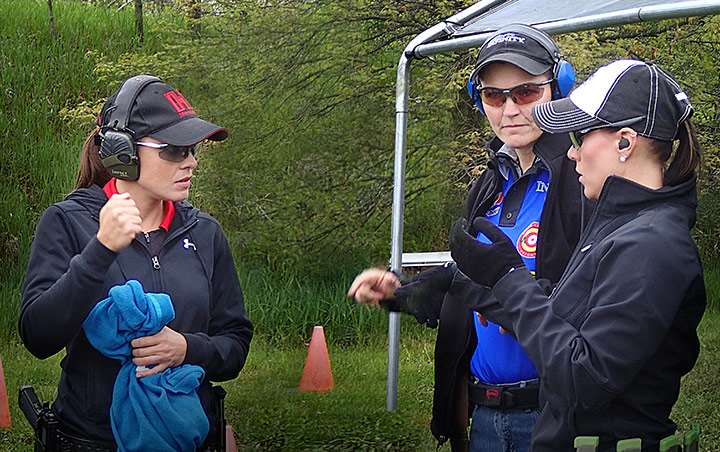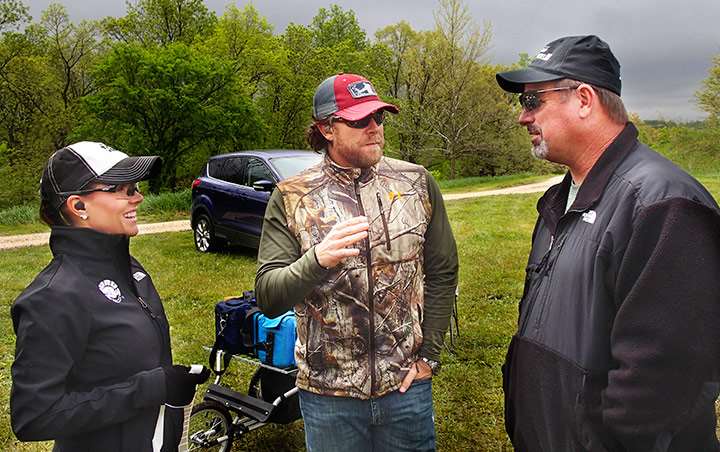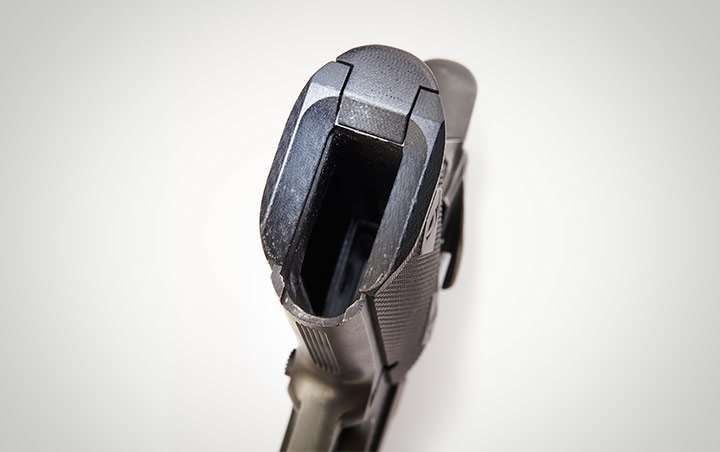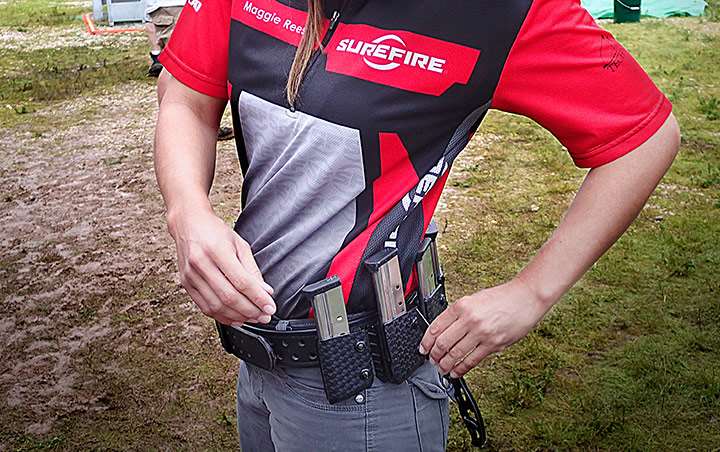
It’s hard to imagine half a dozen people agreeing on anything. Ok, we’ll give you ice cream. And in the Midwest, at least, steak. But beyond that, the going gets tough.
Yet year after year USPSA’s Single Stack Nationals remain astonishingly well attended (there’s always a waiting list). This May was no exception, with 372 people ballooning tiny Barry, Ill.—however temporarily—by nearly 30 percent.
What brings them to this unapologetically 1911-only venue? While it’s no secret that we’re dedicated fans of John Browning’s 102-year-old masterpiece, that hardly seems sufficient. Surely not the historical lure, however deserved, of the Land of Lincoln and of Mark Twain. And we’re not shallow enough to go just anywhere to shoot. (Oh, all right: We are that shallow.) But the question is still worth asking.
Our quest for an answer was helped early on by Dave Thomas, retired executive director of the United States Practical Shooting Association: “It’s USPSA the way it used to be,” he opined, and he ought to know. Before his retirement from USPSA, Single Stack division emerged from the Gulag under his patient eye—essentially banished as it had been by legions of slick red-dot sights, flat-shooting compensators, wide-body frames and Panama Canal-length magazines.
Dave’s words were wisdom, and certainly truth. As for agreement: Well, that speaks for itself.
PASA Park
The Single Stack Nationals venue—Pike Adams Sportsmen’s Alliance, or simply PASA Park—is nothing if not pastoral. Originally the family farm and then shooting haven of owner Dick Metcalf (at that time Handgun Editor at Shooting Times magazine), he and Smith & Wesson brought the Masters International Shooting Championship there in 1986.
A series of range improvements through the years—including “Practical Valley” in 1987—brought USPSA matches there in 1991. Dozens of national and international competitions have been held there over the years.
Through it all, PASA remains what you have the feeling it was always meant to be—a rolling, verdant Midwestern retreat, got up in smokeless powder.
The High and The Mighty
PASA has also been the scene for one of the sporting world’s most remarkable, if little-known, records. In 19 contests, Single Stack Nationals has had only three different men’s champions.
Don’t think this is due to weak fields, however. This year alone, the top 10 men’s finishers had more than 100 national and international titles between them (the top five women had more than 30, by the way). They may have a lot more: We gave up counting to preserve a microscopic sliver of self-respect.
In fact, you’ll see a significant percentage of the world’s best handgun shooters here. Yet you can walk right up to the possessor of a remarkable record and get a smile, handshake and self-deprecating anecdote. Now-17-time winner Rob Leatham (yes, he won again this year) laughed and corrected us as we were introduced to him with a mention of his astonishing feat: “The actual record is 16 wins, and one dead last.” As our squadmate Dale Cauthen told us, “That’s the way he’s always been.”
Try that at Indy, or the Masters, or the Super Bowl: the remark, the record, or the meeting with the champ. Then remember you don’t just get to watch, even up close. You get to take part.
The Not So High and Much Less Mighty
In truth, Single Stack, unlike some other competitions, is within the grasp of regular shooters. You sign up the same way the big players do, and the kit you’ll need won’t break the bank.
Some USPSA divisions—particularly Open, and to a lesser extent, Limited—are legend for the intricacies of their required equipment. A top-drawer Open pistol can make a whale of a hole in $4,000. Limited is a little easier on the budget, say, $2,000-3,000, but you may not have your magazines and “rig” yet.
While you'll see spectacular pistols in terms of performance, precision and cold, hard steel beauty, a decent home theater-sized pile of cash is not required to get through PASA’s tribulations. As long as it’s a 1911, you’re good.
Part of our Nationals plan was to go the other way with our equipment expenditures—not on the cheap, exactly, but a safe, reliable pistol that most anyone could field. Our local go-to equipment adviser, gunsmith and 1911 specialist Gary Kimball, helped us settle on a Rock Island Armory Tactical FS. As much as we would have liked to, we didn’t let Gary work his magic on the pistol—we wanted to shoot it as close to stock as possible within the rules, yet still have a remotely competitive tool. In the end, we swapped in a red fiber Dawson Precision front sight, a slightly softer Wolff recoil spring, a Brownells mag catch spring, and a G10 grip/mainspring housing set from Hogue (a nifty product: great grips and a “free” magwell when the install is complete).
SSN remains the haunt of the big dog: .45 ACP at “major” power factor (bullet weight in grains times velocity in ft/sec greater than 165,000). But other calibers are showing up in growing numbers: .40 S&W, .38 Super and related variants, and 9 mm (both the .38 and 9 mm play at minor power factor—by rule 125,000 or more). To many traditionalists, these last two choices make no sense, as the 20-percent scoring penalty built into minor seems too high a price for the reduced recoil. There is, however, a compensation in the rules in terms of round count: As long the gun still fits in the 815/16" x 6" x 15/8" “box” with the mag inserted, 10 rounds are permitted after the start signal for minor, vs. only eight for major. Having shot SSN at major before, we decided to see if fewer reloads would make up for lower-scoring hits outside the “A” zone.
We mated the RIA up with Wilson Combat mags, a Double Alpha Academy inner/outer belt, BladeTech holster and three Uncle Mike’s mag holders. All told, we had about $1,050 in the entire rig.
Lastly, some practice. After about 2,400 rounds, we had the pistol running nicely indeed, although tough spring weather in Colorado put us two weeks from the match without a clear load choice. Enter Paul Miller of Colorado Cast Bullets and a 162-grain 9 mm round nose. Voilà! Murder on steel, but drilling good groups too, particularly for a non match-barreled pistol.
The Game
A match like SSN consists of multiple stages, a stage being a course of fire consisting of some number of rounds (rarely less than eight; by rule never more than 32) to be fired at a combination of cardboard (usually requiring two hits) and steel targets (which must fall to score). In addition to targets, a stage contains walls, pathways and other props that might need to be carried, stood or sat upon, avoided, scaled, opened, closed or otherwise manipulated while targets are engaged as rapidly as possible and simulated hostage/bystanders (“no-shoot” targets) not hit, all within appropriate safety constraints.
Scoring is easy: Points are based on the quality of your hits less any penalties divided by time, and otherwise known as “hit factor.” Higher is better. Stages do not repeat, particularly at matches like Nationals, where solving each new problem is a major part of success. Oh, draw and reload as needed—all “on the clock.” Easy? Yeah, right.
In a local match, you would expect four to six stages, but SSN goes well beyond that: This year, competitors faced 13 stages (plus the dreaded Chronograph). And few stages indeed are simple “draw, and shoot ‘em as you see ’em.” One stage, for example, had competitors start seated on a park bench with a “newspaper” in their hands; an empty gun and no magazines on their belt or person; with a faux pizza to deliver; magazines spread throughout the stage; doors to open, drawers to open. You get the idea: it’s not a typical “civvy” flat/square range undertaking.
Thursday's Child Has Far to Go
All the planning and prep—but not the worry—ended with the shooter’s meeting early Thursday morning. We headed up into Practical Valley and assembled in squads of eight to 10, in this case with only one familiar face (Tom Knobeloch, also from Colorado Springs). But as we’ve universally found, friends are easy to make once the cases start to fly and the dust kicks up.
About that dust: This was May in Illinois, and it rains—occasionally, it rains a lot. Squad 11 rain gear and bags on targets were on-again, off-again all day long, accompanied by a fine selection of meticulously positioned two-inch-deep puddles—discovered chiefly as the resting place for our magazines.
A course of fire intended to differentiate and crown the world’s best 1911 shooter took its toll, but that’s the point, as our squad-mates told us.
“It may be the old war horse, but there’s a reason that it (the 1911) has endured and inspired versions like the 2011,” said physicist Aaron Sontag from Oak Ridge, Tenn. “The ergonomics are great, and it’s the only platform that I’ve ever picked up and had it just point where I intended it to. The trigger is so much better than the typical production gun, so I really like that aspect of shooting Single Stack.”
His shooting buddy John Stone, a former RECON Marine and security contractor, added, “I really like the idea of having to perform more reloads, shoot more accurately, and execute a stage plan with a bit more precision. It really is a ‘zero or hero’ division, and it feels like I’m getting an extra stage out of every run.”
Thirteen stages later, whether we got something extra out of PASA or it took something extra out of us was up in the air. Measurement was rendered as much in ibuprofen as in hit factor.
West Virginian and USAF vet Roger Ramey summed it up best: “Matches like this are some of the best training anyone can get.”
Friday's Child ...
... may be “loving and giving” according to the old rhyme. But in this case, they were also much better shooters. Perhaps this should be no surprise, as we had the opportunity to follow the women’s “super squad” through their paces on day two.
Mark that word “pace.” We know what this looks like now, thanks to these ladies. If we’ve spun you up enough that you’re considering single stack competition (especially at PASA), any one of these ladies will likely clean your clock. The good news is you’ll probably enjoy it; each and every one—Jessie Duff, Sara Dunivin, Lisa Larson, Lisa Munson, Maggie Reese and Doni Spencer—was an absolute delight.
Like the top men, the women have fascinating differences in outlook and background, and they shared them with humor and generosity. But the notion that the women aren’t every bit the steely-eyed competitors the men are dies early.
“After training for single stack, all my reloads are spectacular!” said Doni Spencer, with a big smile.
Sara Dunivin related how the ever-increasing quality of competition is a major draw.
“The greatest thing going on is the pool of talent is getting larger,” she said. “In years past, a handful of shooters were destined to win every match. They’re still there, (but now) we see new faces at the top of division score sheets on a regular basis.”
After watching Friday’s match, what we can say with certainty is that your stereotypes—if any—simply won’t apply. When these ladies weren’t shooting, they were working the stages with an energy that’s tiring to watch, much less emulate. And when they’re shooting, shut up and pay attention—you will learn something.
More than Nostalgia
We heard Dave Thomas’ appraisal of Single Stack Nationals—“It’s USPSA the way it used to be”—echoed over and over again. We also saw it in the focus on basic skills applied at stratospheric levels: an average round count per stage of 18.69 implies at least two reloads, yet hit factors for top shooters stay near the two “bull’s-eyes” (“A” hits) per second on many stages.At the end of the day, Single Stack Nationals isn’t just about winning and losing, or records, or personalities, or changes through the years. The take-away from Single Stack Nationals is “excellence.”
That may be no surprise when you consider these are world-class athletes at work. But what should surprise you is how deep in the results list you see one- “A”-per-second hit rates, most at non-trivial distances, and with real-world style handguns and ammunition.
At the end of the day, Single Stack Nationals isn’t just about winning and losing, or records, or personalities, or changes through the years. The take-away from Single Stack Nationals is “excellence.”
Many-time Canadian champ Doni Spencer may have summed the competition up best.
“I’m very proud to be a part of this unique sport,” Spencer said. “We’re the R&D for new and improved handguns, and IPSC/USPSA’s top shooters are training our elite law enforcement and military teams. What we’re doing and learning benefits everybody in the long run.”
Writ small, that excellence is embodied in Browning’s 1911, wielded with remarkable safety, lightning speed and astonishing precision; all in a venue where military, law enforcement and citizen shooters can share what they learn.
Writ large, it’s a call to something higher, to the moral, martial and intellectual imperatives necessary to another American excellence: the heritage, practice and diligent protection of liberty.
About the RIA
Matches tend to reveal hardware weaknesses almost as efficiently as duty, and we had some with our Rock Island pistol. In fairness, it was mostly our fault: A grounded magazine should always, always, always be emptied and cleaned, and we failed to do so.
After a thorough dunking, we carefully cleaned the outside of the mag and feed lips, but did not remove the rounds. In our prep for the match, the RIA had been so reliable we thought we could skate by. And we did, for a stage or two. Eventually, however, some of that schmutz made its way to the disconnector, resulting in a gritty, retarded movement of the slide every time the pistol ejected and chambered a round. There was only one actual malfunction, and an ounce or so of oil sluiced out the obstruction; but the balky slide action was a real tempo-buster, with predictable results.



































